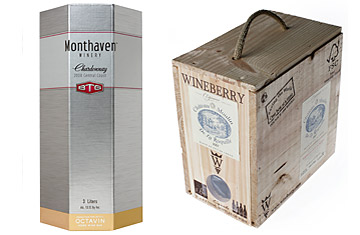
From left: Monthaven Winery chardonnay, Wineberry Bordeaux
Mass-produced wine bottles were a great innovation in the 1600s — the heavy glass was easier to cork and easier to ship than clay or stone jugs. But it wasn't until four centuries later that winemakers started experimenting with eco-friendlier packaging in the form of boxed wine. These rectangular juice boxes on steroids not only cost less to ship but also use vacuum-sealed bags to keep vino tasting fresh for up to six weeks after opening. The main drawback to boxed wine? It looks tacky.
Not tacky enough, mind you, to keep the frugal and environmentally conscious from buying it. According to market researcher Nielsen, sales of 3-liter boxed table wine increased 19.9% during the one-year period ending April 3, while overall sales of table wine edged up just 3.5%. But savvy producers are trying to widen boxed wines' appeal with a second generation of boxes that look a whole lot nicer sitting on a counter or in a fridge for a month and a half.
This spring, Underdog Wine Merchants unveiled the Octavin Home Wine Bar, an artisanal collection of 10 wines in octagonal cylinders. These containers, which started hitting stores in May, do the impossible — they make boxed wines sexy. Some of the six wines whose makers Underdog has partnered with (Monthaven Winery, Silver Birch) look classy and expensive in their cylinders. Others (Big House, Boho Vineyards) are cute, almost flirty. Octavin claims that while packaging for a glass bottle typically costs $2 to $3, an Octavin costs only about $1. The savings, as with other cask wines, are passed along to consumers. Each cylinder, which retails for $22 to $24 and includes as much wine as four standard bottles, costs consumers what three ordinary bottles would. Another benefit: according to Octavin, the cylinders reduce packaging waste 92% and carbon emissions 55% compared with glass bottles.
Another cleverly designed boxed-wine innovation is the use of wood to replace cardboard boxes. Wineberry America's Berry Boxes are crafted with wood from sustainable forests that, after the wine is finished, can be turned into bird feeders or lunch boxes. These $33-to-$49 boxes of Bordeaux, Burgundy, Beaujolais and Rhone wines started hitting boutique shops last July, and immediate strong sales surprised just about everyone. As with conventional boxed wine, these 3-liter wooden cases come with a collapsible plastic bladder inside. The bag deflates as wine is dispensed, preventing oxygen, which spoils wine, from entering.
And last but not least comes California's popular Red Truck, which last year started selling its Chardonnay and its highly regarded red blend in minibarrels made of recyclable plastic that looks like wood. In their first nine months, more than 300,000 of these 3-liter barrels, at a suggested retail price of $29.99 a pop, were sold. The patent-pending Opti-Flow bottom of the barrel slopes from back to front, creating an incline that delivers wine to the spout with no tipping necessary — even for the last few glasses.
In addition to being creatively designed, most of these wines capture a sense of place — some are from prestigious regions in France and are rarely found in casks in the U.S.
"The packaging attracts people, but it's really about the wine," says Adam Richardson, director of international winemaking for Underdog Wines. "The effort and focus we put into $15 bottles is the same as the effort and focus we put into the Octavin wines." Indeed, what distinguishes his portfolio — and Red Truck's and Wineberry's — from other boxed wine are the grapes. For example, blending expert Georgetta Dane has used up to 24 different grape varieties in the Big House Red she puts into Octavin cylinders, and many of the grapes in the Boho Zinfandel hail from 100-year-old vines. In the end, quality, not aesthetics, is the reason Richardson calls the new crop of boxed wines "the alternative to the alternative."
